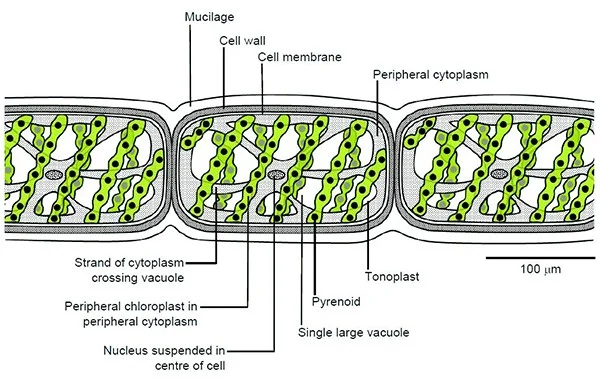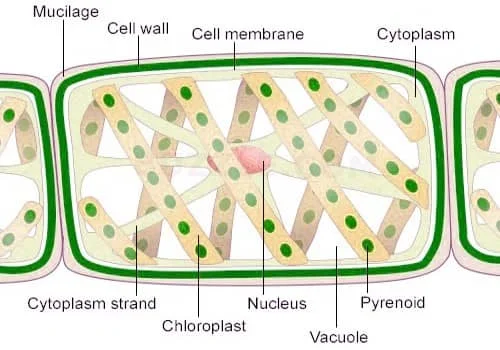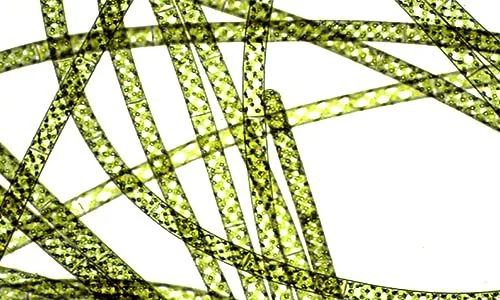Spirogyra is a sophisticated, filamentous green alga, found in freshwater represented by about 300 species. It is also identified as pond silk, as its fiber burnishes like silk due to the occurrence of mucilage.
The vegetative body structure of spirogyra
A) External features
- The vegetative body of Spirogyra is unbranched and filamentous.
- The plant body is long, slender and multicellular.
- Numerous elongated and identical cells are arranged vertically in the filamentous body
- At the posterior end of the filament, there is a unicellular compressed part, called holdfast or hapteta by which the plant body remains attached with any substratum.
- Spirogyra has a cell wall, nucleus, pyrenoid, and spiral chloroplasts.
It is very unusual among the plant-like protists. The green filamentous alga – Spirogyra has a multicellular body with comparable cells.
B) Cell wall
- Cell wall consists of three layers of which inner two layers are made of pectose and the outer layer is composed of cellulose.
- The filament is usually surrounded by a membrane made of mucilage.
- The cell wall consists of an internal coat of cellulose and an external layer of pectin, which is dependable for the slippery surface of the algae.

Fig: Structure of Spirogyra
C) Protoplasm
Following parts are present in protoplasm:
- Plasma membrane: It is situated just beneath the cell wall. It covers the inner matters of the protoplasm.
- Cytoplasm: It is situated inside the cell wall, very close to the plasma membrane.
- Chloroplast: The chloroplast of Spirogyra is a long, spirally coiled ribbon which may indenture to structure a small, almost immediately rod.
D) Cell vacuole
Each cell has a large vacuole placed at the center.
The chloroplasts shape a curved around the vacuole and have particular bodies known as pyrenoids that hoard starch.
E) Nucleus
Each all contains a single nucleus. It remains suspended within the cytoplasm with the help of some cytoplasm strains. The nucleus is situated at the midpoint, which is balanced in the cell with the help of protoplasmic strands
F) Chloroplast
Chloroplasts of this all are long and flattened as tape. They are arranged spirally around the space. A number of chloroplasts present in each cell depend on the bests of its species. Usually, the number of chloroplasts may vary from one to seven. The mainly conspicuous characteristic of the cell is the spiral chloroplast surrounding the green chlorophyll.
G) Pyrenoids
- Some silvery granules present in each chloroplast are called pyrenoids
- Plenty of protein piles up in the pyrenoids
- Starch is deposited as recent food around the pyrenoids.
- Pyrenoids generally perhaps purpose to fix carbon.
The life cycle of Spirogyra
In Spirogyra, three types of the life cycle can be seen – vegetative and sexual cycles are most familiar. The life cycle of Spirogyra is haploidic where the haploid vegetative fiber represents a lingering gametophyte production and the brief sporophyte stage is represented by diploid zygospore (zygote). In the life cycle, the thalloid vegetative fibers multiples by vegetative and sexual reproductions are most general while asexual reproduction occurs infrequently.

Fig: Spirogyra cell parts
During the growing season, the vegetative fiber of Spirogyra undergoes crumbling, so that each fragment separately develops into a fresh fiber by repeated cell division and elongation. In positive circumstances, fragmentation is the majority regular technique of reproduction.
Vegetative reproduction happens from beginning to end the fragmentation of the filaments. It occurs in dissimilar ways. In case of mechanical injuries, the spirogyra filament breaks into fragments, and each portion expands into a new filament. This occurs when the warmth and the pH of the water transforms.
Asexual reproduction in spirogyra involves the shape of akinetes, aplanospores, or azygospores/parthenospores. During critical circumstances, some types of spirogyra form thick-walled resting spores called akinetes.
Sexual reproduction in Spirogyra can be of two types: scalariform conjugation and lateral conjugation. In scalariform conjugation, two filaments come together and stay side by side.












